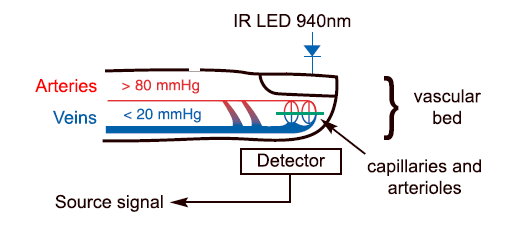The perfusion index (PI) is a technical indicator that reflects the level of the effective signal the tracker can process.
The angioscan uses optical sensors operating in the near-infrared region to reliably record the pulse wave.

Scheme of the optical sensor installed on the terminal phalanx of the finger. Infrared radiation passes through the finger and is registered by the photo detector, which converts the light into either a voltage (light/voltage converter) or a frequency (light/frequency converter)
The primary signal used for further analysis and processing is a photoplethysmogram (a non-invasive signal determined by pulse changes of blood volume in tissues). The developed technology of registration and contour analysis of the pulse volume wave helps obtain meaningful information on the stiffness of elastic arteries.
Values under 1.0 mean a poor signal level. The possible reasons include cold arms, too dark nail polish, and arterial pathology. In this case, the text results may be false. If PI is lower than 1.0, the tracker will show a warning of possible false results. Depending on the reason behind a decreased perfusion index, it's recommended to:
- warm the hands
- turn the device so that the sensor light passes under the fingernail, rather than through it
- change the hand



